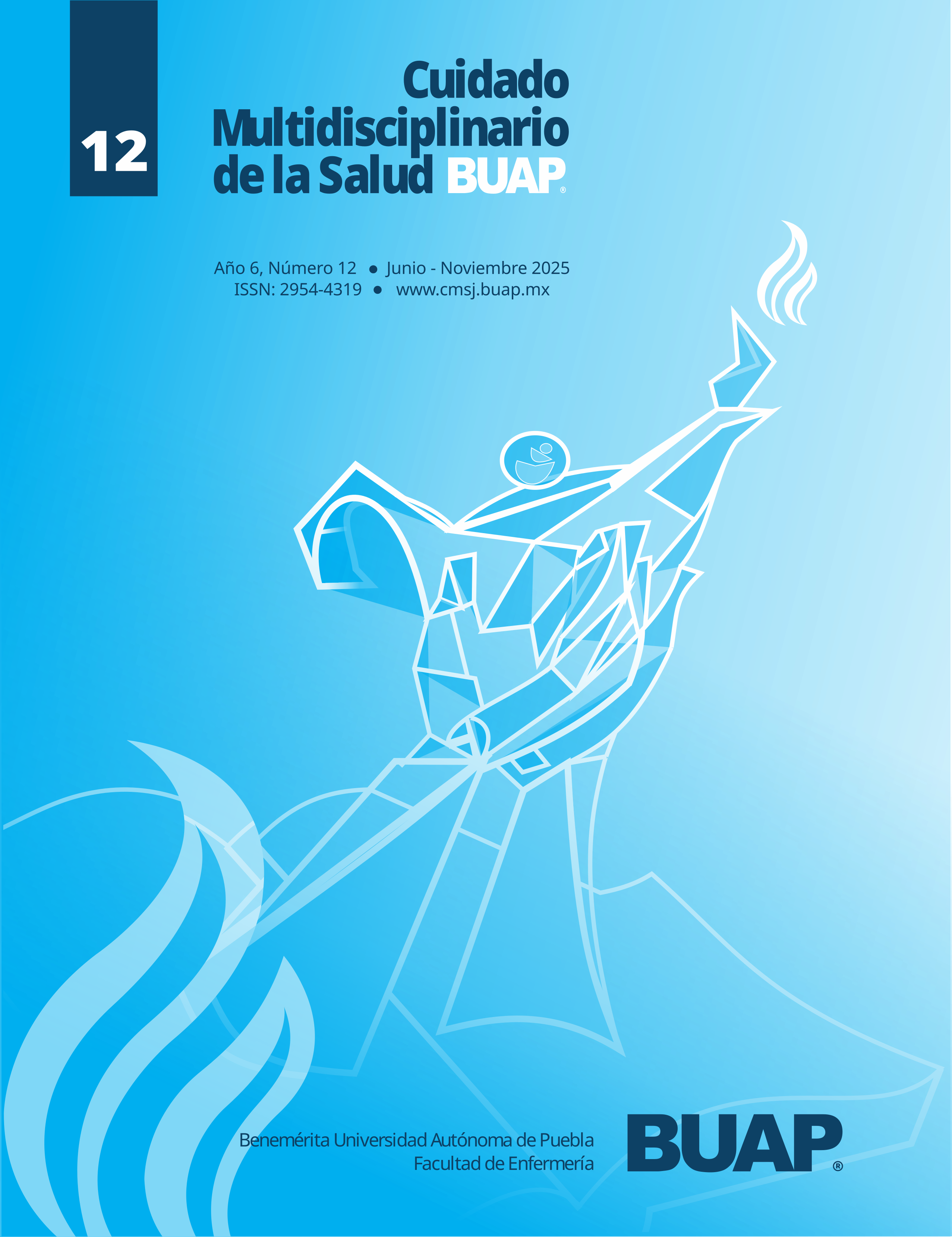Effective treatment with enzymatic ointment made from natural plants for wound healing
Keywords:
Wounds, Healing, Wound Healing, Soap, OintmentsAbstract
Introduction. The problems in wound healing are inflammation, infection and necrotic tissue. There are natural components and enzymatic technology, which offer deep and sustained cleaning, which are highly resistant to conventional treatments.
Objective. Analyze the effect of CD3 ointment in wound healing
Methodology. Quasi-experimental study in 15 patients with wounds ≤ 4cm. neutral soap and CD-3 ointment were used. The wound was moistened, and 0.25 ml of soap was applied for every 4 cm of wound, ointment was applied using 1.25 grams for every 5 cm of wound.
Results. The wound at first healing and at tenth healing. At first healing, 52.8 % of the wounds measured between 3.1 to 4 cm, 27.4 % measured between 2.1 to 3 cm and 19.8 % measured between 1 to 2 cm. When assessing the wounds in the tenth healing 33 % had wound closure while the other wounds had a satisfactory reduction compared to their arrival, 33 % reduced to less than 1 cm, 26.4% reduced between 2.1 to 3 cm and 6.6% measured 3.1 to 4 cm.
References
Aguirre Villa, M.A. (2022). Derecho de proteccion a la propiedad intelectual de la medicina tradicional de los pueblos y comunidades indigenas en México. [Tesis de Maestría]. Universidad Autónoma del Estado de Morelos, Cuernavaca, México. http://riaa.uaem.mx/handle/20.500.12055/2760
Alarcón Burneo, F. R. (2024). La miel de abeja como alternativa natural de cicatrización en el pie diabético. Revista Social Fronteriza, 4(2), 1-11. https://doi.org/10.59814/resofro.2024.4(2)227
Arribas Blanco, J.M., Castelló Fortet, J.R., Rodríguez Pata, N., Sánchez Olaso, A. & Antequera Pérez, A. (2002). Cirugía menor en heridas (laceraciones). Heridas en cara y manos. SEMERGEN - Medicina de Familia, 28(5), 249-264. https://doi.org/10.1016/S1138-3593(02)74066-5
Bellés Andreu, S., Sepúlveda Gallardo, C. & Arroyo Huidobro, M. (2024). El impacto de la nutrición en la curación de las úlceras por presión. MPG Journal, 4(64), 1-8. https://mpgjournal.mpg.es/index.php/journal/article/view/822
Castillo-Cermeño, E. V. (2024). Conocimiento sobre curación de heridas quirúrgicas. Revista Ciencia Multidisciplinaria CUNORI, 8(2), 1-15. https://doi.org/10.36314/cunori.v8i2.278
De Oliveira-Silva, E., Lôbo de Souza, M., Ferreira de Melo, D., Gonzaga da Costa, L. A,. de Lima Arruda Holanda, B. A.,Vicente Nishimura, R. H & Rolim Neto, P. J. (2024). Phytopharmacological aspects of Mimosa tenuiflora (Willd.) poir: a systematic review of preclinical data. Phytochemistry Reviews, 23, 1183-1203. https://doi.org/10.1007/s11101-024-09919-x
Dominguez-Saavedra, G. & Hernandez-Galván, J. M. (2021). Actualización en el manejo de heridas. Cirugía Plástica, 31(3), 124-136. https://dx.doi.org/10.35366/103715
Hernández Piñeyro, A. M., Landero Rendón, R. G., Martínez Vázquez, N. K. & Uribe Flores, M. M. (2024). Secretos de la naturaleza: Descubre cómo los extractos naturales mejoran la cicatrización de heridas. +Ciencia. Revista de la Facultad de Ingeniería, (36), 39-41. https://revistas.anahuac.mx/index.php/masciencia/article/view/2595
Évili da Silva, T., Germano Cidrack do Vale, C. M., Silva de Brito, T. (2024). Evidências clínicas do uso de plantas medicinais e fitoterápicos na cicatrizaÇão de feridas cutâneas: uma revisão integrativa. Revista Ciência Plural, 10(1), 1-21. https://doi.org/10.21680/2446-7286.2024v10n1ID35109
Goyo, B., Lanzotti, M., Torrealba, A. & De Felice, L. G. (2020). Aplicación de terapia de presión negativa en el manejo de pacientes con heridas complejas. Journal of Negative & No Positive Results, 5(12), 1490-1503. https://doi.org/10.19230/jonnpr.3827
Ibáñez Perelló, A. (2024). Propiedades de la miel como alternativa al tratamiento de heridas. [Tesis de Maestría]. Universitat de les Illes Balears, Palma, Illes Balears. http://hdl.handle.net/11201/165143
Leite Diniz, L. R., Luiz Calado, L., Sucupira Duarte, A. B. & Pergentino de Sousa, D. (2023). Centella asiatica and Its Metabolite Asiatic Acid: Wound Healing Effects and Therapeutic Potential. Metabolites, 13(2), 276, 1-16. https://doi.org/10.3390/metabo13020276
López-Villarreal, S. M., Chávez Montes, A., Leos-Rivas, C., Rodríguez-Luis, O., Castro-Ríos, R. & Pérez-Hernández, R. (2022). Evaluación antimicrobiana y coagulante de extractos de cinco vegetales de interés etnobotánico. Horizonte sanitario, 21(3), 397-402. https://revistahorizonte.ujat.mx/index.php/horizonte/article/view/5001
Lozada Méndez, M. A., Campos Guzman, N. R. & Martínez Delgado, L.(2020). Tratamientos no convencionales utilizados en la curación de las heridas. Paradigmas Socio-Humanísticos, (2)2, 45-61. https://doi.org/10.26752/revistaparadigmassh.v2i2.520
Mengarelli, R. H., Sarmiento, A., Mercado, V. & Pérez, L. (2024). Evaluación del rendimiento de un servicio especializado en Heridas en un hospital de alta complejidad. Heridas y Cicatrización, 14(1), 6-9. https://heridasycicatrizacion.es/images/site/2024/4_Original_SEHER14.1.pdf
Mejía-Benavidez, J. E. & Jiménez-García, S. N. (2023). Extractos de plantas como tratamientos complementarios en el proceso de cicatrización de heridas de pie diabético. ACC CIETNA: Para el cuidado de la salud, 10(1), 214-221. https://revistas.usat.edu.pe/index.php/cietna/article/view/931
Perdomo Pérez, E.,Soldevilla Agreda, J. & García Fernández, F. P. (2020). Relación entre calidad de vida y proceso de cicatrización de heridas crónicas complicadas. Gerokomos, 31(3), 166-172. https://gerokomos.com/wp-content/uploads/2020/10/31-3-2020-166.pdf
Ruiz Rodas, M. A. (2024). Pomada enzimática [MX. Patente No. 010088]. Instituto Mexicano de la propiedad Industrial, Gobierno de México. https://siga.impi.gob.mx/
Soto-Ojeda, G. A, Cortés-Pomares, P. C. & Villanueva-Lendechy, M. A. (2021). Formulación de un gel a base del extracto etanólico de Verbesina persicifolia y Caléndula officinalis para su evaluación antimicrobiana y cicatrizante. RINDERESU, 6(1-2), 1-17. http://rinderesu.com/index.php/rinderesu/article/view/113
Triana-Ricci, R., Martinez-de-Jesus, F., Aragón-Carreño, M. P., Saurral, R., Tamayo-Acosta, C. A., Garcia-Puerta, M., Bernal, P. V., Silva-Quiñones, K., Feijo, D. F., Reyes, C. & Herrera-Arbeláez, J. M. (2021). Recomendaciones de manejo del paciente con pie diábetico. Curso de instrucción. Revista Colombiana de Ortopedia y Traumatologia, 35(4), 303-329. https://doi.org/10.1016/j.rccot.2021.12.001
Vásquez-Hernández, S. M., Rico-Ardila, D. L., Gómez-Camargo, L. N. & Álvarez-Quintero, L. M. (2021). Costo-efectividad de las intervenciones de enfermería para el manejo de úlceras por pie diábetico: revisión sistemática. MedUNAB, 24(1), 13-26. https://doi.org/10.29375/01237047.3832
Downloads
Published
How to Cite
Issue
Section
License
Copyright (c) 2025 The moral rights belong to the author, the economic rights belong to the Benemérita Universidad Autónoma de Puebla.

This work is licensed under a Creative Commons Attribution-NonCommercial-NoDerivatives 4.0 International License.
The moral rights belong to the author, the economic rights belong to the Benemérita Universidad Autónoma de Puebla.






